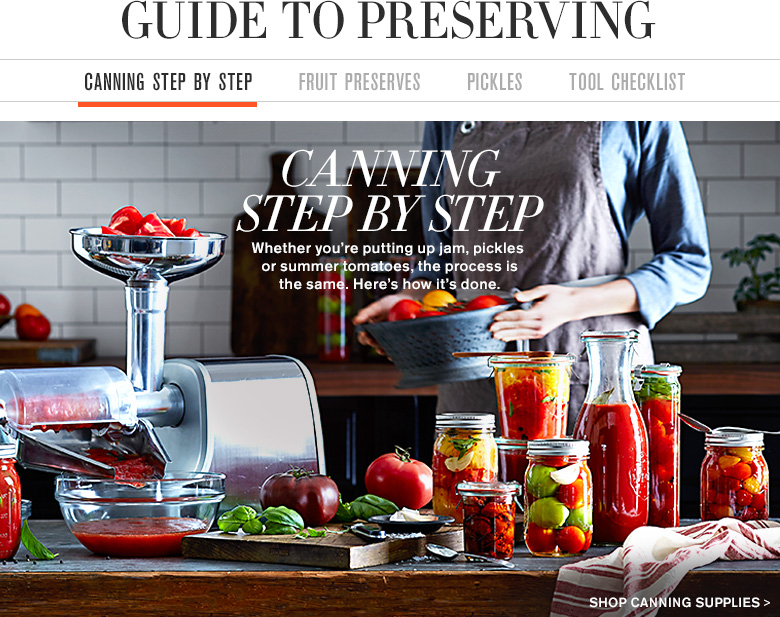
Wash the jars, lids and bands well in hot soapy water by hand or in a dishwasher. New lids must be used for each batch, but screw bands in good condition can be reused. Place the lids in a small saucepan with water to cover, bring to a simmer (180°F/82°C) and maintain the simmer until you are ready to use them. Do not boil.
If your recipe calls for 10 minutes or less of processing time, the jars must be sterilized before they are filled. To sterilize them, fill a boiling-water canner pot two-thirds full of hot water. Fill the jars with hot water and, using a rubber-coated jar lifter, lower the jars, one at a time, onto the rack in the water-filled pot, making sure they are covered by at least 1 inch of water. Bring the water to a boil over high heat and boil for 10 minutes.
To ensure a proper seal, always keep jars warm until you're ready to use them. Either turn off the heat under the canner and leave the sterilized jars in the hot water, removing and drying them as needed, or transfer the jars from the canner into a low-temperature oven to keep warm. Always use a jar lifter to safely transfer jars from hot water or an oven for filling.
Insert the rack into the boiling-water canner. Fill the canner about two-thirds full with water and bring to a boil over high heat. At the same time, bring a teakettle full of water to a boil, and then adjust the heat to maintain a simmer (you may need additional boiling water to cover the filled jars once they are in the canner).
Working with one sterilized jar at a time, place a funnel over the opening. Fill the jars with your prepared food using a ladle or slotted spoon, leaving the amount of headspace called for in the recipe. Run a chopstick around the inside edge of the jar to release any air bubbles trapped inside, then adjust the headspace if necessary. Wipe the rim with a clean, damp cloth. Use rubber-coated tongs or a magnetic wand to remove a hot sterilized lid from the simmering water, and dry with a clean kitchen towel. Top the jar with the warm lid then screw a band over the lid just until it is secure.
Arrange the filled jars in the canner, using a jar lifter to lower them onto the rack. Make sure the jars are covered by at least 2 inches of water. Cover the pot with the lid and begin timing the processing for your recipe after the water has returned to a rapid boil.
Once the time is up, use a lifter to remove the jars from the boiling water. Place the jars on a kitchen towel or rack and let cool completely. Within minutes or hours, you will hear the "ping" of the jar lids being sucked into a vacuum seal.
When the jars are cool, test the seal by gently pressing on the top of each lid. It should be taut and rigid to the touch and slightly indented. If the lid bounces back and makes a clicking noise when you press it, the seal may not be adequate for food safety. To test it further, unscrew the band and gently lift the lid with your fingertips. If you are able to pick up the entire jar by holding the edges of the lid, the seal is good. If the lid slips easily from the jar rim, the seal is insufficient. Store any jar that does not have a proper seal in the refrigerator for the time specified in individual recipes.
Most jars with proper seals can be stored for up to 1 year. Label the jars with their contents and the date, and then store in a cool, dark place. Each time you open a new jar, check the contents for signs of spoilage: a sour or musty aroma, or any visible mold or discoloration. Discard the contents of any jar that does not appear to have maintained a tight seal throughout its storage.













